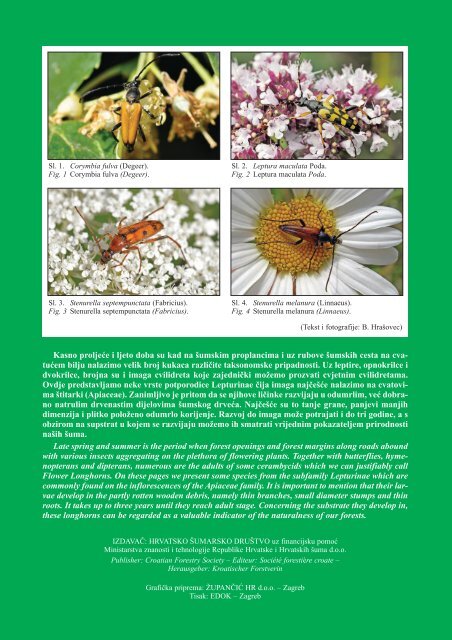Create successful ePaper yourself
Turn your PDF publications into a flip-book with our unique Google optimized e-Paper software.
Sl. 1. Corymbia fulva (Degeer).<br />
Fig. 1 Corymbia fulva (Degeer).<br />
Sl. 2. Leptura maculata Poda.<br />
Fig. 2 Leptura maculata Poda.<br />
Sl. 3. Stenurella septempunctata (Fabricius).<br />
Fig. 3 Stenurella septempunctata (Fabricius).<br />
Sl. 4. Stenurella melanura (Linnaeus).<br />
Fig. 4 Stenurella melanura (Linnaeus).<br />
(Tekst i fotografije: B. Hrašovec)<br />
Kasno proljeće i ljeto doba su kad na šumskim proplancima i uz rubove šumskih cesta na cvatućem<br />
bilju nalazimo velik broj kukaca različite taksonomske pripadnosti. Uz leptire, opnokrilce i<br />
dvokrilce, brojna su i imaga cvilidreta koje zajednički možemo prozvati cvjetnim cvilidretama.<br />
Ovdje predstavljamo neke vrste potporodice Lepturinae čija imaga najčešće nalazimo na cvatovima<br />
štitarki (Apiaceae). Zanimljivo je pritom da se njihove ličinke razvijaju u odumrlim, već dobrano<br />
natrulim drvenastim dijelovima šumskog drveća. Najčešće su to tanje grane, panjevi manjih<br />
dimenzija i plitko položeno odumrlo korijenje. Razvoj do imaga može potrajati i do tri godine, a s<br />
obzirom na supstrat u kojem se razvijaju možemo ih smatrati vrijednim pokazateljem prirodnosti<br />
naših šuma.<br />
Late spring and summer is the period when forest openings and forest margins along roads abound<br />
with various insects aggregating on the plethora of flowering plants. Together with butterflies, hymenopterans<br />
and dipterans, numerous are the adults of some cerambycids which we can justifiably call<br />
Flower Longhorns. On these pages we present some species from the subfamily Lepturinae which are<br />
commonly found on the inflorescences of the Apiaceae family. It is important to mention that their larvae<br />
develop in the partly rotten wooden debris, namely thin branches, small diameter stumps and thin<br />
roots. It takes up to three years until they reach adult stage. Concerning the substrate they develop in,<br />
these longhorns can be regarded as a valuable indicator of the naturalness of our forests.<br />
IZDAVAČ: HRVATSKO ŠUMARSKO DRUŠTVO uz financijsku pomoć<br />
Ministarstva znanosti i tehnologije Republike Hrvatske i Hrvatskih šuma d.o.o.<br />
Publisher: Croatian Forestry Society – Editeur: Société forestière croate –<br />
Herausgeber: Kroatischer Forstverin<br />
Grafička priprema: ŽUPANČIĆ HR d.o.o. – Zagreb<br />
Tisak: EDOK – Zagreb

















